Similar to traditional or dry-heat saunas, an infrared sauna generates heat to induce sweating, which in turn relaxes tense muscles and allows you to take a break from your busy day. What sets this distinct is the approach taken. Infrared saunas use electromagnetic radiation to heat the air to temperatures between 150 and 190 degrees Fahrenheit, whereas traditional saunas rely on stoves or electric heaters.
In a dry-heat sauna, some people generate steam by pouring water over hot rocks, while others choose to use electricity or wood to raise the temperature. The typical temperature in a traditional sauna is between 180 and 190 degrees Fahrenheit, so be prepared for some serious heat. In addition, there is not even a trace of wetness there, as humidity levels rarely get above 10% to 20%.
Infrared saunas use lamps that emit infrared light, which heats the body directly and emits electromagnetic radiation. In terms of light output, both near-infrared and far-infrared saunas are viable options for light therapy sessions. These lights are primarily red, orange, and yellow.
Instead of just heating the air in a sauna, infrared saunas allow the wavelengths to penetrate the tissue and heat the body. This explains why infrared saunas have become more popular.
An infrared sauna is a type of sauna that can be found in health clubs and spas, or it can be bought and used at home. Whether you opt for a fixed home sauna or a portable infrared sauna is a personal preference.
Using infrared light as its primary heat source, traditional saunas like infrared saunas are a modern take on an old practise. This kind of sauna is also referred to as a far-infrared sauna. Infrared light occupies what is called the "far" part of the electromagnetic spectrum. Regular sauna use raises core body temperature via evaporative cooling. Infrared saunas are different from typical saunas because the infrared light they release warms you from the inside out.
Saunas are appealing because they have a similar effect on the body as moderate exercise. Such responses include, for instance, profuse perspiration and a rapid heartbeat. Those who cannot tolerate the extreme heat of a typical sauna can still benefit from utilising an infrared sauna because it provides these effects at temperatures that are lower than those of a regular sauna. Is there any evidence that these alterations actually improve health? Perhaps.
High blood pressure, type 2 diabetes, congestive heart failure, dementia and Alzheimer's disease, headaches, and rheumatoid arthritis are just some of the chronic health conditions that have been shown to benefit with infrared sauna therapy. However, more in-depth research is needed to confirm these findings. Traditional sauna users who were patients were also included in several of these studies.
FAQs About Sauna
Studies have shown that our metabolic rate can increase by around 30% after an hour-long sauna session. The higher our metabolic rate, the more calories we are burning.
The sauna/steam room should be used “2-3 times a week for no more than 10-20 minutes at a time,” Jay says. Some individuals like to opt for intervals. “You can do 15 to 20 minutes inside the room, take a 5 minute break outside the room, and then go back inside, repeating this for 3-4 cycles.”
Always remove your jewellery before showering and bathing, or using saunas and steam rooms. Even sterling silver and real gold can be dulled over time due to a build-up of chalk contained in water and residue from soaps, shower gels and steam.
Saunas appear safe for most people. However, people with uncontrolled high blood pressure and heart disease should check with their doctors before taking a sauna. Here are some general precautions: Avoid alcohol and medications that may impair sweating and produce overheating before and after your sauna.
For some, the cold immersion after a hot sauna can improve blood flow. Indeed, cold shower enthusiasts maintain that a cold shower is rejuvenating, simply because of increased blood flow. The hot/cold experience elevates heart rate, adrenaline, and the release of endorphins.
What Exactly Is Far Infrared?
Saunas that utilise far infrared rays heat your body directly, as opposed to warming the air around you, and this has several health benefits. They are often referred to as "infrared heat therapy chambers" due to the fact that the heating elements in them radiate heat in the form of light onto the user's body.
Far infrared saunas use just around 20% of the heat they produce to warm the air, with the remaining 80% going towards warming your body. Its radiating heat can penetrate the skin far further than in a traditional sauna.
Because the air surrounding your body is not heated up during a session in a far infrared sauna, many individuals find them more comfortable to use. Far infrared saunas, in contrast to traditional saunas, maintain much lower temperatures.
Most infrared saunas are far infrared, however full-spectrum saunas also exist and radiate in the near, mid, and far infrared ranges. Many people feel that there are benefits to using different kinds of energy.
- Near-infrared rays penetrate the upper layers of skin and activate the body's innate capacity for repair and renewal. It's the one everyone recommends for boosting immunity and mending wounds quickly.
- Mid-infrared rays have longer penetration and can thus better improve circulation, release oxygen, and treat wounded tissues located deeper within the body. Getting into this range is supposed to help you unwind and ease your muscles.
- The far infrared spectrum features the longest wavelength. It may be able to enter the fat cells, where it would subsequently stimulate the metabolism and remove pollutants.
When Do You Use an Infrared Sauna?
Infrared sauna sweating is different from traditional sauna sweating in a number of fundamental ways. These differences include the use of a different heating technology and the purported inclusion of additional benefits.
Infrared saunas deliver heat chiefly by electromagnetic radiation. This type of radiation lacks the risks of UV light since its wavelengths are much longer and its frequency is much lower. While traditional saunas can reach temperatures well into the hundreds, infrared saunas only need to reach temperatures of 120 to 140 degrees Fahrenheit to be effective.
Upon entering an infrared sauna, you will be directed to a bench to sit or lie down on; however, some saunas have mats laid out instead. The infrared bulbs, which are what generate the heat, will give off visible light. On average, a session can last between 15 and 30 minutes. In contrast to traditional saunas, where the dry, extremely intense heat compels you to start sweating almost immediately, you won't start sweating for almost 15 minutes. So don't worry; you'll emerge from the experience just as drenched as you would have after a session in a conventional sauna. Sometimes you'll get to hear music, and that's cool. Because of the potential for the heat to damage the functionality of cell phones, their usage is frequently restricted in these situations.
Sauna use, and particularly far infrared sauna use, has been linked to a plethora of health benefits. While not all of these advantages are supported by high-quality scientific research, it doesn't imply you won't get some or all of them through sauna use.
Studies on saunas typically have a small sample size due to a lack of interested people willing to take part in the study. Some of the most commonly referenced research are decades old, with many of the same scholars responsible for many studies.
In 2018, the journal Evidence-Based Complementary and Alternative Medicine published a meta-analysis of sauna research. The authors of the study discussed the present state of knowledge about the benefits of saunas to health.
"It has been suggested that regular dry sauna use has positive health effects. There is a need for more high-quality data on the frequency and scope of unexpected effects. Further study is needed to determine the best types of saunas, the optimal frequency and duration of sauna bathing for various health outcomes, and the specific clinical groups who would most benefit from sauna therapy."
What follows is a synopsis of the findings of several scientific studies on the benefits of saunas and, more specifically, far infrared saunas.
Consequences of infrared sauna use
Astonishingly, infrared sauna use has been linked to improvements in things like relaxation and sleep quality. Relieving sore muscles appears first.
But, as is the case with any good, there are also downsides to consider. Before cranking up the temperature, be sure you understand the risks and side effects that could occur.
Indicators and symptoms like these may be brought on by excessive sauna use, as reported by a 2018 systematic review of the topic.
- pain from mild to severe heat
- reduced arterial tension (hypotension)
- light-headedness
- leg ache that won't last
- irritation of the airwaysF
One small study from 2013 found that regular sauna use reduced sperm count and motility. The research was conducted in a sauna, with participants participating in two 15-minute sessions every week for three months.
Moreover, Dr. Ashish Sharma, a board-certified internist and hospitalist at Yuma Regional Medical Center, shed light on the potential risks of sauna use.
The Dangers of Overheating: Heat Exhaustion and Heat Stroke
Overheating one's body and developing a heat-related illness is possible in anyone, even those in the best of health, if they misuse the sauna. Yet, there is always some sort of advanced notice given. If you are not aware with the signs of heat stroke and heat exhaustion, you can learn more about them by visiting the Academy of Family Physicians' page on the subject, which can be found at this link. The general rule of thumb is to leave the sauna if you start to feel too hot and cool off under the shower.
For too long in a sauna, you risk impairing your body's ability to recuperate from the consequences of overheating. By exposing the body to radiant heat, which travels through the air as light waves, a sauna can boost the core body temperature. Overheating warning signs are often misunderstood because people associate them with general feelings of warmth, such as those experienced in a sauna. A lot of people make this error.
If you linger in the sauna for longer than recommended, the temperature could go dangerously high. Owing to the possibility of this happening, you must take considerable caution with regards to the length of time you are going to spend in the sauna. While relaxing in a sauna, if you feel your skin getting clammy or if you start to feel dizzy or nauseous, you should get out of there as quickly as possible.
One of the best ways to prevent heat exhaustion or heat stroke is to carry a thermometer with you and use it to keep track of the temperature and make sure you are getting enough fluids.
Several authorities advise keeping a thermometer close at hand for anyone partaking in a sauna detoxification programme, as participants may spend an hour or more in the sauna each day.
In a typical dry heat sauna, the user risks serious burns if they touch the hot rocks or heater. The concealed heaters in a well-designed infrared sauna eliminate the risk of burns caused by accidental contact.
Keep in mind that the part of your skin closest to the far infrared heaters may turn red due to the increased blood flow in that area, but that this redness will dissipate within an hour or two after you leave the sauna and won't feel uncomfortable.
Dehydration
One of the most common problems that can occur from using a sauna is dehydration, which comes with a variety of symptoms that one must be aware of in order to avoid it.
You may remember that the last time you spent twenty-five to thirty minutes in the sauna, you felt a bit parched and your skin dried off. It's conceivable that you're becoming dehydrated if you spend time in a sauna and then feel lightheaded, headachey, thirsty, and exhausted.
It's wise to replenish your fluid stores with a swig of H2O both before and after your sauna session. Get a drink of water to refresh yourself and take a pause. It's crucial that you don't get any water on yourself when you're doing this; the humidity in the sauna will rise and give you discomfort if you do.
You should wait at least an hour after a sauna session before drinking anything to rehydrate. A full glass of water every 15 to 20 minutes will keep you hydrated throughout the entire procedure. Besides booze, sugary drinks like soda and fruit juices should be avoided during this activity due to their contribution to heat exhaustion and dehydration.
Dr. Sharma warns that infrared saunas might lead to heat exhaustion due to their usage of dry heat. Dehydration, heat exhaustion, and maybe heat stroke are all possible outcomes of prolonged sauna use.
Use of an infrared sauna carries considerable risk, despite the fact that it has no established downsides.
Overheating, dehydration, and lightheadedness are all possibilities when using an infrared sauna, just as they are when using a conventional sauna. Drinking enough water before and after the activity can help prevent this from happening in most circumstances. Trying out a sauna calls for complete sobriety, so don't drink or do drugs before you get in.
Those with specific health conditions should exercise caution when using infrared saunas. Even while infrared saunas are regarded to be safe and may even provide some health benefits to patients with heart disease, people who have recently experienced a heart attack or unstable angina (a condition that lowers the quantity of blood flowing into the heart) are recommended against using them.
Home Infrared Saunas and Electromagnetic Field Dangers
If we look at how each band of the electromagnetic spectrum affects living tissue, we can categorise it as either ionising or non-ionizing.
The electromagnetic spectrum includes an ionising band where the short wavelengths, high frequencies, and high intensities of ionising radiation are all present. There is a subset of the electromagnetic spectrum known as "ionising radiation," which includes rays like x-rays, gamma rays, and ultraviolet light. Ionizing radiation can damage living tissue and genetic material by knocking electrons out of their usual orbits in atoms and molecules.
Radiation burns are a possible side effect of exposure to ionising electromagnetic fields. When it comes to the harmful effects of ionising radiation, sunburn is by far the most prevalent. Sun exposure causes one million annual incidences of skin cancer. Based on the rates at which their citizens absorb radiation, some countries have established acceptable exposure limits for ionising frequencies of electromagnetic energy. These restrictions are put in place to protect users from suffering burns and other thermal injuries.
The non-ionizing band of the electromagnetic spectrum is distinguished from the ionising band by its significantly longer wavelengths, lower frequencies, and lower intensities. Radio waves, microwaves, infrared, and visible light are the four main types. Low-frequency (ELF) radio waves and the infrared (IR) light emitted by saunas are both located in the same non-ionizing area of the electromagnetic spectrum.
The range of natural electromagnetic fields (EMF) or very low-frequency radio waves that are in harmony with the human body and the earth's magnetic field begins at 10 hertz (Hz) (ELF). Our home appliances produce fake ELFs at 60 hertz (Hz), which are regulated by national norms.
What Potential Risks May People Face if They Spent Time in an Infrared Sauna, Where Electromagnetic Fields (Emf) Might Be Present?
Household currents, like those emitted by an infrared sauna, produce low-power, low-frequency electromagnetic radiation, which is generally considered to be harmless to human health.
Using the Comet assay, scientists from the University of Basel in Switzerland showed that human cells exposed to a 50 Hz electromagnetic field for short durations (but not constantly) at a flux intensity of 1 mT (or 10 G) generated a minor but substantial increase in the quantity of DNA fragmentation. That amount of exposure is too high to be considered within the acceptable range of risk.
Non-ionizing electromagnetic field radiation from modern infrared saunas with flexible carbon heating panels occurs at 1 G or less at a distance of 4 cm from the heating source, 0.5 Hz at a distance of 3 feet from the power source, and a flux density of.001 mT or less. To increase DNA fragmentation, an electromagnetic field of 50 Hz is required; this amount is much smaller than the maximum safe exposure of 10 G, or 10,000 mG.
Several, mutually cancelling, low-frequency electromagnetic fields are produced inside the infrared sauna. Flexible Biophoton Nano carbon infrared heating innovations used in home saunas have a patented design that cancels out Extremely Low-Frequency EMF with Far Infrared EMF and neutralises the tissue special absorption rate of extremely low-frequency EMF to influence absorption of the more attractive Far Infrared EMF tuned to the resonant frequency of the human body. This technique is currently being used in Celebration Saunas to counteract the increased tissue-specific absorption of EMF, in addition to minimising the effects of extremely low-frequency electromagnetic fields (EMF) on absorption. With a configuration that minimises system complexity while still generating sufficient infrared heat and minimal amounts of electromagnetic radiation at certain wavelengths, Biophoton Nano Carbon's infrared heating technology is used to create panels and mechanisms. This configuration is shared by the systems and the panels.
Our Standard heaters put out 10mG of heat when placed within 4cm, and only 5mG when placed within 24cm. If you're interested in reading our report on low EMF levels, you can find it at this link.
At 10 centimetres, our Ultra-Low EMF / 0 EMF heaters produce 0.3mG. If you are curious about our report on extremely low EMF levels, click here.
Via electromagnetic waves, all forms of life are able to communicate with one another. Each of your cells emits electromagnetic radiation (EMR) and relies on EMR from the surrounding environment to stay alive (for example, visible light for the melatonin cycle and UV radiation for the production of vitamin D).
Far infrared, also known as body heat, is produced in the mitochondria of our cells and aids in the regulation of critical processes while also providing support for our health. This EMF is distinct from the electromagnetic field (EMF) produced by our central nervous system, brain, and heart. These EMFs play a crucial role in keeping our bodies healthy.
A Sauna Session Can Facilitate the Delivery of Fat-Stored Drugs to the Bloodstream.
The solubility of certain chemicals in fat means that they are taken into the body on a regular basis but are kept there because they are either too much for the body to handle or too difficult for the body to process.
Mobilizing and sweating away any medication stored in your fat from prior exposures can have negative effects on your body. This is especially true for anaesthetics that have been stored in your fat.
(If you're like most people, when you think back on all the medications you've taken and procedures you might have had, you'll realise that you've been exposed to a lot of different drugs throughout your life.)
Both conventional and infrared saunas carry the possibility of this happening, but the chemical utilised to create the sauna can make a difference.
Our experience has taught us that a sauna detox programme is not something that should be attempted without first learning as much as possible about the subject...and then following the method to the letter. (Be sure to return to see our sauna cleansing pages that are now under revision.)
Infrared Saunas: When Not to Use Them
Experts believe that infrared saunas are safe for the great majority of users.
Take extra care if you have any kind of medical condition, whether it's acute or chronic, if you're taking any kind of medication, or if you have any type of medical device implanted in your body.
Before exposing yourself to extreme heat, Cook-Bolden advises checking in with your primary care physician.
The following, as cited by Cook-Bolden, increase the risk of dehydration and overheating in humans:
- condition characterised by low blood pressure
- possessing a kidney disease
- if you're taking a drug that is known to make you dizzy, like a diuretic or a treatment that lowers your blood pressure.
This is by no means an all-inclusive list of ailments that necessitate staying away from infrared saunas or receiving the okay from a doctor before using one.
- Motor and nerve system disorders. Cook-Bolden argues that an increased risk for heat or burn injuries exists for those with neurological deficits because they may not be able to feel or react correctly to the degree of heat.
- Things to consider while expecting. You shouldn't use the sauna unless your doctor has given you the green light to start doing so while you're pregnant.
- Causes related to getting older. If your age prevents you from using a sauna safely, you shouldn't. Dehydration and disorientation brought on by the dry heat are especially dangerous for the elderly since they increase the risk of falling. Always check with your kid's doctor before letting them use an infrared sauna.
- Insufficient strength or a compromised immune system. Cook-Bolden that people with impaired immune systems get in touch with the facility to make sure it is in good shape and follows rigors cleaning techniques and procedures in accordance with industry standards. After that, you need to get clearance to use the facility from your primary care doctor.
- Breaks in the skin's surface. Please wait until any surgical incisions or open wounds have closed before proceeding. Then, you should check in with your primary care physician or another healthcare provider before beginning infrared sauna sessions.
- Disorders of the cardiovascular system Those with cardiovascular disease or a history of cardiac arrhythmias like atrial fibrillation should see their doctor before using a sauna, as stated by Sharma. An elevated heart rate and potentially an abnormal heart rhythm have both been linked to sauna use.
Sharma cautions against using saunas if the risks outweigh the benefits, but notes that the sauna's positive effects are similar to those of light exercise in that they result from the body's physiological response to the increased heart rate and perspiration.
"If you can't stand the sauna or you can't find an infrared sauna where you live, you can still gain similar — and even greater — health advantages by engaging in cardiovascular and strength training routines," he says. Scientists have discovered that saunas help lower inflammation and increase blood flow.
The use of an infrared sauna has the potential to be a highly effective method of stress reduction and health promotion. Although there is a dearth of data regarding its long-term benefits, a few preliminary studies have shown promise that it may be preferable to the conventional dry sauna. If you do not have any life-threatening medical concerns, sweating it out in an infrared sauna may be healthy for your body.
So, how do you feel about infrared saunas? The present, if insufficient, research suggests that taking part in one for as little as fifteen minutes a day may be good for your heart and reduce chronic pain symptoms. However, there don't seem to be any significant health risks right now.
Before doing anything else, consult your family doctor. According to the evidence, trying an infrared sauna has very low risk and high potential reward. Yet, if you're still unsure about whether or not to give one a shot, the data says that you should.
Conclusion
Infrared saunas use electromagnetic radiation to heat the air to temperatures between 150-190 degrees Fahrenheit, allowing the wavelengths to penetrate the tissue and heat the body. Infrared sauna therapy has been shown to benefit chronic health conditions, such as high blood pressure, type 2 diabetes, congestive heart failure, dementia and Alzheimer's disease, headaches, and rheumatoid arthritis. Infrared saunas have been linked to a variety of health benefits, but more research is needed to determine the best types of saunas, optimal frequency and duration, and the specific clinical groups who benefit from them. Indoor sauna use has been linked to improvements in relaxation and sleep quality, but there are risks and side effects that can occur. Heat exhaustion and heat stroke can occur from prolonged sauna use, so it is important to carry a thermometer and replenish fluid stores with a swig of H2O both before and after a session.
Home Infrared Saunas and Electromagnetic Field Dangers include overheating, dehydration, and lightheadedness, as well as radiation burns, sunburn, and skin cancer. Biophoton Nano Carbon's infrared heating technology cancels out Extremely Low-Frequency EMF with Far Infrared EMF and neutralises the tissue special absorption rate of extremely low-frequency EMF. Sauna sessions can help deliver fat-stored drugs to the bloodstream, but they can also increase the risk of dehydration and overheating in humans. Infrared saunas can be dangerous for those with neurological deficits, motor and nerve system disorders, insufficient strength, and compromised immune systems. Infrared saunas may be beneficial for the cardiovascular system, but should be consulted with a doctor before taking part.
Content Summary
- Similar to traditional or dry-heat saunas, an infrared sauna generates heat to induce sweating, which in turn relaxes tense muscles and allows you to take a break from your busy day.
- Infrared saunas use electromagnetic radiation to heat the air to temperatures between 150 and 190 degrees Fahrenheit, whereas traditional saunas rely on stoves or electric heaters.
- In terms of light output, both near-infrared and far-infrared saunas are viable options for light therapy sessions.
- This kind of sauna is also referred to as a far-infrared sauna.
- High blood pressure, type 2 diabetes, congestive heart failure, dementia and Alzheimer's disease, headaches, and rheumatoid arthritis are just some of the chronic health conditions that have been shown to benefit with infrared sauna therapy.
- Because the air surrounding your body is not heated up during a session in a far infrared sauna, many individuals find them more comfortable to use.
- When Do You Use an Infrared Sauna?Infrared sauna sweating is different from traditional sauna sweating in a number of fundamental ways.
- Infrared saunas deliver heat chiefly by electromagnetic radiation.
- Sauna use, and particularly far infrared sauna use, has been linked to a plethora of health benefits.
- "It has been suggested that regular dry sauna use has positive health effects.
- Before cranking up the temperature, be sure you understand the risks and side effects that could occur.
- If you are not aware with the signs of heat stroke and heat exhaustion, you can learn more about them by visiting the Academy of Family Physicians' page on the subject, which can be found at this link.
- One of the best ways to prevent heat exhaustion or heat stroke is to carry a thermometer with you and use it to keep track of the temperature and make sure you are getting enough fluids.
- Get a drink of water to refresh yourself and take a pause.
- Dehydration, heat exhaustion, and maybe heat stroke are all possible outcomes of prolonged sauna use.
- Drinking enough water before and after the activity can help prevent this from happening in most circumstances.
- Those with specific health conditions should exercise caution when using infrared saunas.
- Home Infrared Saunas and Electromagnetic Field DangersIf we look at how each band of the electromagnetic spectrum affects living tissue, we can categorise it as either ionising or non-ionizing.
- The non-ionizing band of the electromagnetic spectrum is distinguished from the ionising band by its significantly longer wavelengths, lower frequencies, and lower intensities.
- Low-frequency (ELF) radio waves and the infrared (IR) light emitted by saunas are both located in the same non-ionizing area of the electromagnetic spectrum.
- Non-ionizing electromagnetic field radiation from modern infrared saunas with flexible carbon heating panels occurs at 1 G or less at a distance of 4 cm from the heating source, 0.5 Hz at a distance of 3 feet from the power source, and a flux density of.001 mT or less.
- Flexible Biophoton Nano carbon infrared heating innovations used in home saunas have a patented design that cancels out Extremely Low-Frequency EMF with Far Infrared EMF and neutralises the tissue special absorption rate of extremely low-frequency EMF to influence absorption of the more attractive Far Infrared EMF tuned to the resonant frequency of the human body.
- This technique is currently being used in Celebration Saunas to counteract the increased tissue-specific absorption of EMF, in addition to minimising the effects of extremely low-frequency electromagnetic fields (EMF) on absorption.
- With a configuration that minimises system complexity while still generating sufficient infrared heat and minimal amounts of electromagnetic radiation at certain wavelengths, Biophoton Nano Carbon's infrared heating technology is used to create panels and mechanisms.
- If you're interested in reading our report on low EMF levels, you can find it at this link.
- Mobilizing and sweating away any medication stored in your fat from prior exposures can have negative effects on your body.
- Our experience has taught us that a sauna detox programme is not something that should be attempted without first learning as much as possible about the subject...and then following the method to the letter. (
- Take extra care if you have any kind of medical condition, whether it's acute or chronic, if you're taking any kind of medication, or if you have any type of medical device implanted in your body.
- Before exposing yourself to extreme heat, Cook-Bolden advises checking in with your primary care physician.
- condition characterised by low blood pressure possessing a kidney disease if you're taking a drug that is known to make you dizzy, like a diuretic or a treatment that lowers your blood pressure.
- Motor and nerve system disorders.
- Things to consider while expecting.
- You shouldn't use the sauna unless your doctor has given you the green light to start doing so while you're pregnant.
- If your age prevents you from using a sauna safely, you shouldn't.
- Always check with your kid's doctor before letting them use an infrared sauna.
- After that, you need to get clearance to use the facility from your primary care doctor.
- Then, you should check in with your primary care physician or another healthcare provider before beginning infrared sauna sessions.
- Disorders of the cardiovascular system Those with cardiovascular disease or a history of cardiac arrhythmias like atrial fibrillation should see their doctor before using a sauna, as stated by Sharma.
- Sharma cautions against using saunas if the risks outweigh the benefits, but notes that the sauna's positive effects are similar to those of light exercise in that they result from the body's physiological response to the increased heart rate and perspiration.
- The use of an infrared sauna has the potential to be a highly effective method of stress reduction and health promotion.
- Although there is a dearth of data regarding its long-term benefits, a few preliminary studies have shown promise that it may be preferable to the conventional dry sauna.
- If you do not have any life-threatening medical concerns, sweating it out in an infrared sauna may be healthy for your body.
- The present, if insufficient, research suggests that taking part in one for as little as fifteen minutes a day may be good for your heart and reduce chronic pain symptoms.
- However, there don't seem to be any significant health risks right now.
- Before doing anything else, consult your family doctor.
- According to the evidence, trying an infrared sauna has very low risk and high potential reward.






